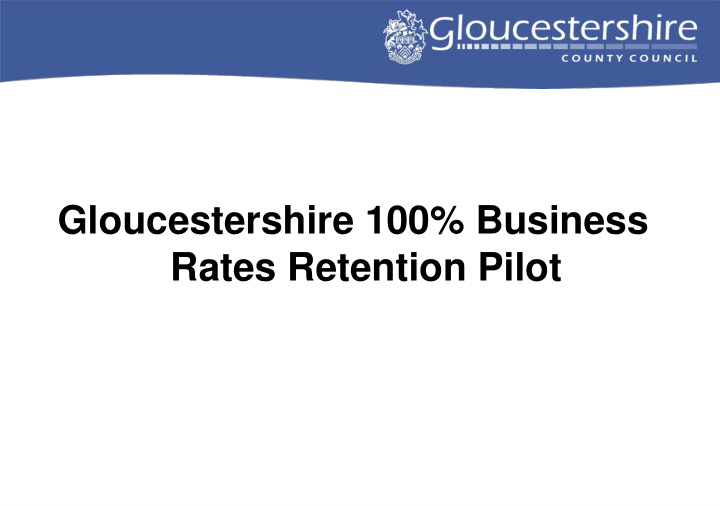



Gloucestershire 100% Business Rates Retention Pilot
2018/19 GCC £389.2 Million Budget Sources of Finance Business Rates 24% £95.5m Other Grant 3% £10.9m Council Tax 73% £282.8m
Business Rates Retention (BRR) • Main funding mechanism from central government for local government since April 2013 • In October 2015 the Government announced its intention to enable local government as a sector to retain all business rates raised locally, ie 100% BRR. • The Government also committed itself to a full review of the needs and redistribution mechanism for local authority funding through the Fair Funding Review (FFR). • Aim for BRR and FFR to be implemented by 2020/21 • Huge variations in business rates across country: • Westminster Returns 90% of rates collected to central government • Lancashire Receives a top up of 83% due to low Business Rate Base
Background on the current system • 50/40/10 central / district / county • Spending “need” set by central government • Tariff / top up • Pooling – reduced levy on growth
BRR – How it Works: Current 50% System Terminology: Top Up Grant : In the 50% scheme upper tier authorities need to be brought up to their baseline “need” and this is done by a “top - up” grant. Tariff: In the 50% scheme lower tier authorities gain too much, and therefore they have to pay a “tariff” to central government to bring them back down to their “need” Levy: all collection authorities pay a levy on growth above the baseline capped at 50% S31 : this is a compensation grant as a result of Budget Statement changes that remove money from the BR system, eg Small Business Rate Relief SEDF: Strategic Economic Development Fund
Benefits / Risks from Pooling • Benefits : • Reduced levy on growth • More income retained in Gloucestershire (est. £3m) • Joint SEDF pot from first 20% of gain • Residual split 80/20 district / county • Risks: • If business rate growth is low, a pooled authority will not trigger a “safety net” payment from Government which it would receive if it did not pool. Partner authorities therefore bear more risk as loss is shared
100% BRR Pilot - Overview • One year pilot • Pilots offered to improve understanding of two tier areas like Gloucestershire as risk and gain varies in different settings • Local authorities in a pilot forego Revenue Support Grant (RSG) and Rural Services Delivery Grant (RSDG) – worth £21.6m in total to Gloucestershire • For GCC as an upper tier authority we move from being a top up authority (receiving a grant of £52m) to a tariff authority (paying back £11m to govt)
Pilot Authorities • Berkshire, • Derbyshire, • Devon, • Gloucestershire, • Kent and Medway, • Leeds, • Lincolnshire, • Solent, • Suffolk and • Surrey.
BRR – How it Works: Pilot 100% System
100% BRR Pilot – Financial benefit • Estimated benefit £9.2m • Shared: • GCC £4.6m • District £2.8m • SEDF £1.8m
GCC Pilot Gain Spending Plans • Estimated benefit to GCC £4.6m • Spending Plans as follows: • Children’s Social Care £2.6m • Adult Social Care £1.0m • Highways £0.53m • Electric Vehicle Infrastructure £0.47m • Total £4.6m
100% BRR Pilot - Risks Key risks: • Revaluations and appeals leading to reduced income • 2017/18 was a revaluation year so normally get peak in revaluation appeals the year following this • Appeals risk – ongoing appeals affect income streams • Currently significant appeal ongoing with NHS Trusts who are claiming charitable status, which would lead to an 80% loss of income • Closure of businesses • results in loss of business rates income eg closure of Maplin's, Toys R Us, and Carpet Right • Businesses moving to the central list • results in loss of income locally
Overall Governance • Technical Working Group – meet six times a year • Pool / Pilot Management Team (PMT) - meet regularly, as part of the normal cycle of Chief Financial Officer Meetings, with the Business Rates Pilot an agenda item on a quarterly basis. • Gloucestershire Economic Growth Joint Committee (GEGJC) - PMT report to GEGJC at least 4 times per year on the financial performance of the Pool / Pilot • Distribution – based on pre agreed percentages
Internal Governance • Monthly meetings with Head of Finance and Strategic Finance Director • Officers feed into technical working group alongside district reps . • Pool Management Team (PMT) – officers sit on the PMT, which meets quarterly • Internal reporting and allocation of funding via Budget Monitoring report to Cabinet
Timelines • Draft figures available 1 st February 2019 • National Non Domestic Rates 1 (NNDR) Forecasts for 2019/20 • Collection Fund Surplus / Deficit from 2018/19 • Final figures available April 2019 • Outturn position, NNDR 3, for 2018/19 • Pilot benefit for 2018/19 • Additional cash to be distributed / clawed back
Questions?
Recommend
More recommend